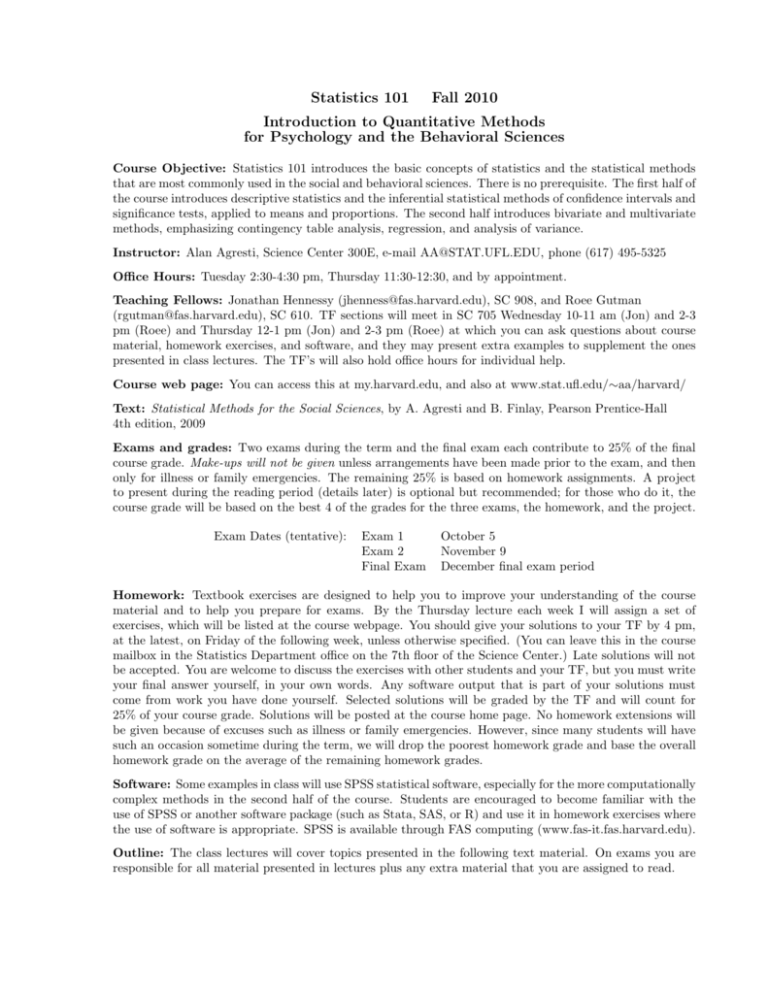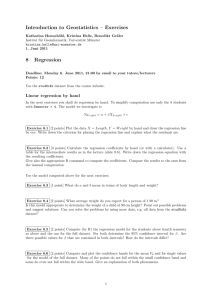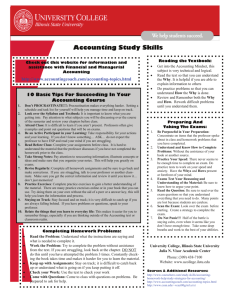
Statistics 101
Fall 2010
Introduction to Quantitative Methods
for Psychology and the Behavioral Sciences
Course Objective: Statistics 101 introduces the basic concepts of statistics and the statistical methods
that are most commonly used in the social and behavioral sciences. There is no prerequisite. The first half of
the course introduces descriptive statistics and the inferential statistical methods of confidence intervals and
significance tests, applied to means and proportions. The second half introduces bivariate and multivariate
methods, emphasizing contingency table analysis, regression, and analysis of variance.
Instructor: Alan Agresti, Science Center 300E, e-mail AA@STAT.UFL.EDU, phone (617) 495-5325
Office Hours: Tuesday 2:30-4:30 pm, Thursday 11:30-12:30, and by appointment.
Teaching Fellows: Jonathan Hennessy (jhenness@fas.harvard.edu), SC 908, and Roee Gutman
(rgutman@fas.harvard.edu), SC 610. TF sections will meet in SC 705 Wednesday 10-11 am (Jon) and 2-3
pm (Roee) and Thursday 12-1 pm (Jon) and 2-3 pm (Roee) at which you can ask questions about course
material, homework exercises, and software, and they may present extra examples to supplement the ones
presented in class lectures. The TF’s will also hold office hours for individual help.
Course web page: You can access this at my.harvard.edu, and also at www.stat.ufl.edu/∼aa/harvard/
Text: Statistical Methods for the Social Sciences, by A. Agresti and B. Finlay, Pearson Prentice-Hall
4th edition, 2009
Exams and grades: Two exams during the term and the final exam each contribute to 25% of the final
course grade. Make-ups will not be given unless arrangements have been made prior to the exam, and then
only for illness or family emergencies. The remaining 25% is based on homework assignments. A project
to present during the reading period (details later) is optional but recommended; for those who do it, the
course grade will be based on the best 4 of the grades for the three exams, the homework, and the project.
Exam Dates (tentative):
Exam 1
Exam 2
Final Exam
October 5
November 9
December final exam period
Homework: Textbook exercises are designed to help you to improve your understanding of the course
material and to help you prepare for exams. By the Thursday lecture each week I will assign a set of
exercises, which will be listed at the course webpage. You should give your solutions to your TF by 4 pm,
at the latest, on Friday of the following week, unless otherwise specified. (You can leave this in the course
mailbox in the Statistics Department office on the 7th floor of the Science Center.) Late solutions will not
be accepted. You are welcome to discuss the exercises with other students and your TF, but you must write
your final answer yourself, in your own words. Any software output that is part of your solutions must
come from work you have done yourself. Selected solutions will be graded by the TF and will count for
25% of your course grade. Solutions will be posted at the course home page. No homework extensions will
be given because of excuses such as illness or family emergencies. However, since many students will have
such an occasion sometime during the term, we will drop the poorest homework grade and base the overall
homework grade on the average of the remaining homework grades.
Software: Some examples in class will use SPSS statistical software, especially for the more computationally
complex methods in the second half of the course. Students are encouraged to become familiar with the
use of SPSS or another software package (such as Stata, SAS, or R) and use it in homework exercises where
the use of software is appropriate. SPSS is available through FAS computing (www.fas-it.fas.harvard.edu).
Outline: The class lectures will cover topics presented in the following text material. On exams you are
responsible for all material presented in lectures plus any extra material that you are assigned to read.
Chapter and Topic
Text Pages
Homework Problems (optional parenthesized)
1. Introduction to Statistics
1-7
2, 3, (5, 17)
2. Sampling and Measurement
11-21
1-3, 7, 13, 14, 22, 27, 34, 36, 37 (5, 24, 38)
3. Descriptive Statistics
Univariate description
31-55
Bivariate description
55-61
6, 10ab, 11, 19, 22, 24, 25, 28, 30, 35 (8, 33, 34ab)
39, 41, 43, 59, 69, 70, 72, 73, 74, 78, (33, 43, 64, 66, 68)
48, 49, 50, (47, 51, 52)
4. Probability & Sampling Distributions
Probability, normal distributions
85-99
8ab, 9ab, 10abc, 11ab, 12ab, 17, 21, 23,
(3, 8c, 9cd, 10de, 11cde, 12cd, 19, 47)
27, 29, 33, 41, 42, 46, 50-53, 57, (36, 54, 55)
5. Inference: Estimation
Confidence interval for proportions
Confidence interval for means
Sample size determination
107-116
116-123
123-129
4, 7, 12, 13, 47, 48, 66-68, 77, (8, 18, 76)
21, 24, 32, 49a, 69-71, 73, (22, 25, 28, 54)
35, 41, 44, 62, (34, 38, 39)
6. Inference: Significance Tests
Mean: Steps of significance test
Proportion: Steps of significance test
Decisions and types of errors
143-155
156-159
159-166
166-169
169-173
1-3, 9, 11, 37a, 39, 52-55, (6)
15, 40, 42, (14, 16, 21, 65)
17, 18, 24, 25, 45, 50, 51, 59, 61,
(22, 23, 26, 27, 46, 63)
29, 30, 56, (28, 31, 57)
33, 34
7. Comparison of Two Groups
Comparing proportions
Comparing means
Matched samples
183-190
191-193, 197-201
193-197
1, 9, 11, 16, 17, 59, 62, (8, 12, 14, 17, 47, 65)
21, 23, 32b, 41, 49, 50, 60, 61, 63, (5, 6, 22, 52, 55)
26, (27, 28, 31)
8. Association for Categorical Variables
Contingency tables, Chi-squared
Residuals
Summarizing association
221-229
229-233
233-239
1, 3, 5, 9, 10, 29a, (2, 4, 40, 44)
11, 16, (14)
18, 20, 22, (17)
9. Linear Regression and Correlation
Regression model, least squares
Correlation and r2
Inference, assumption, influence
255-268
269-276
276-289
1, 3, 7, 10, (25, 63, 66)
11-12, 18, 20, 38, 58-61, (13, 67, 68)
29, 32, 42, 50-55
10. Intro. to Multivariate Relationships
Association/causality, statistical control
Relationships, statistical interaction
301-307
307-313
3, 5, 7b, 33, 34, 40, (7a, 39)
11, 14, 16, 32, 42-44, (41, 45)
11. Multiple Regression
Multiple regression and correlation
Inference, interaction, comparing models
321-335
335-346
1, 4-7, 19, 46, 49, 66, (67)
25, 44, 48(a-f), (48(h-k,m,n))
12. Comparing Groups: Anal. of Variance
Comparing means: F test
Multiple comparisons
ANOVA using regression
Two-way and factorial ANOVA
369-376
376-378
378-381
382-391
2, 5, 8c, 38, 51, 52, (1, 3, 6, 24, 36, 57)
10, 14, 42, (12, 40, 53)
15, (16)
17, 22, (23, 41, 44, 45, 48)
13-15. Advanced topics (brief intro.)
Quantitative and categorical predictors
Modelling nonlinearity
Logistic regression
413-422
462-473
483-493
Sampling distributions
Finding power and P(Type II error)
Binomial test for small n
73-85











